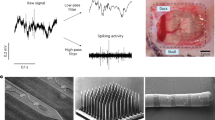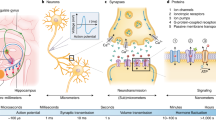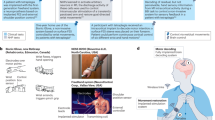Abstract
Recent studies have shown that it is possible to create functional, bidirectional, real-time interfaces between living brain tissue and artificial devices. It is reasonable to predict that further research on brain–machine interfaces will lead to the development of a new generation of neuroprosthetic devices aimed at restoring motor functions in severely paralysed patients. In addition, I propose that such interfaces can become the core of a new experimental approach with which to investigate the operation of neural systems in behaving animals.
This is a preview of subscription content, access via your institution
Access options
Subscribe to this journal
Receive 12 print issues and online access
$189.00 per year
only $15.75 per issue
Buy this article
- Purchase on Springer Link
- Instant access to full article PDF
Prices may be subject to local taxes which are calculated during checkout



Similar content being viewed by others
References
Nobunaga, A. I., Go, B. K. & Karunas, R. B. Recent demographic and injury trends in people served by the model spinal cord injury care systems. Arch. Phys. Med. Rehabil. 80, 1372–1382 (1999).
Bomze, H. M., Bulsara, K. R., Iskandar, B. J., Caroni, P. & Skene, J. H. Spinal axon regeneration evoked by replacing two growth cone proteins in adult neurons. Nature Neurosci. 4, 38–43 (2001).
Chapin, J. K., Moxon, K. A., Markowitz, R. S. & Nicolelis, M. A. L. Real-time control of a robot arm using simultaneously recorded neurons in the motor cortex. Nature Neurosci. 2, 664–670 (1999).
Talwar, S. K. et al. Rat navigation guided by remote control. Nature 417, 37–38 (2002).
Wessberg, J. et al. Real-time prediction of hand trajectory by ensembles of cortical neurons in primates. Nature 408, 361–365 (2000).
Serruya, M. D., Hatsopoulos, N. G., Paninski, L., Fellows, M. R. & Donoghue, J. P. Instant neural control of a movement signal. Nature 416, 141–142 (2002).
Taylor, D. M., Tillery, S. I. & Schwartz, A. B. Direct cortical control of 3D neuroprosthetic devices. Science 296, 1829–1832 (2002).
Wolpaw, J. R., McFarland, D. J., Neat, G. W. & Forneris, C. A. An EEG-based brain-computer interface for cursor control. Electroencephalogr. Clin. Neurophysiol. 78, 252–259 (1991).
Kennedy, P. R. & Bakay, R. A. Restoration of neural output from a paralyzed patient by a direct brain connection. Neuroreport 9, 1707–1711 (1998).
Birbaumer, N. et al. A spelling device for the paralysed. Nature 398, 297–298 (1999).
Keith, M. W. et al. Tendon transfers and functional electrical stimulation for restoration of hand function in spinal cord injury. J. Hand Surg. 21, 89–99 (1996).
Schmidt, E. M. Single neuron recording from motor cortex as a possible source of signals for control of external devices. Ann. Biomed. Eng. 8, 339–349 (1980).
Nicolelis, M. A. L. Actions from thoughts. Nature 409, 403–407 (2001).
Donoghue, J. P. Connecting cortex to machines: recent advances in brain interfaces. Nature Neurosci. Suppl. 5, 1085–1088 (2002).
Nicolelis, M. A. L. & Ribeiro, S. Multi-electrode recordings: the next steps. Curr. Opin. Neurobiol. 12, 602–606 (2002).
Le Masson, G., Renaud-Le Masson, S., Debay, D. & Bal, T. Feedback inhibition controls spike transfer in hybrid thalamic circuits. Nature 417, 854–858 (2002).
Kalaska, J. F. & Crammond, D. J. Cerebral cortical mechanisms of reaching movements. Science 255, 1517–1523 (1992).
Kalaska, J. F., Scott, S. H., Cisek, P. & Sergio, L. E. Cortical control of reaching movements. Curr. Opin. Neurobiol. 7, 849–859 (1997).
Mitz, A. R., Godschalk, M. & Wise, S. P. Learning-dependent neuronal activity in the premotor cortex: activity during the acquisition of conditional motor associations. J. Neurosci. 11, 1855–1872 (1991).
Fetz, E. E. & Baker, M. A. Operantly conditioned patterns of precentral unit activity and correlated responses in adjacent cells and contralateral muscles. J. Neurophysiol. 36, 179–204 (1973).
Fetz, E. E. & Finocchio, D. V. Correlations between activity of motor cortex cells and arm muscles during operantly conditioned response patterns. Exp. Brain Res. 23, 217–240 (1975).
Olds, J. The limbic system and behavioral reinforcement. Prog. Brain Res. 27, 144–164 (1967).
Fetz, E. E. Operant conditioning of cortical unit activity. Science 163, 955–957 (1969).
Fetz, E. E. & Finocchio, D. V. Operant conditioning of specific patterns of neural and muscular activity. Science 174, 431–435 (1971).
Iriki, A., Tanka, M. & Iwamura, Y. Coding of modified body schema during tool use by macaque postcentral neurones. Neuroreport 7, 2325–2330 (1996).
Ishibashi, H. et al. Tool-use learning selectively induces expression of brain-derived neurotrophic factor, its receptor trkB, and neurotrophin 3 in the intraparietal multisensorycortex of monkeys. Brain Res. Cogn. Brain Res. 14, 3–9 (2002).
Brooks, R. A. Flesh and Machines: How Robots Will Change Us (Knopf, New York, 2002).
Young, T. On the theory of light and colours. Phil. Trans. R. Soc. Lond. 92, 12–48 (1802).
Hebb, D. O. Organization of Behavior (John Wiley & Sons, New York, 1949).
Georgopoulos, A. P., Schwartz, A. B. & Ketter, R. E. Neuronal population coding of movement direction. Science 233, 1416–1419 (1986).
Johnson, M. T. & Ebner, T. J. Processing of multiple kinematic signals in the cerebellum and motor cortices. Brain Res. Rev. 33, 155–168 (2000).
Messier, J. & Kalaska, J. F. Covariation of primate dorsal premotor cell activity with direction and amplitude during a memorized-delay reaching task. J. Neurophysiol. 84, 152–165 (2000).
Johnson, M. T. V., Mason, C. R. & Ebner, T. J. Central processes for the multiparametric control of arm movements in primates. Curr. Opin. Neurobiol. 11, 684–688 (2001).
Gribble, P. L. & Scott, S. H. Overlap of internal models in motor cortex for mechanical loads during reaching. Nature 417, 938–941 (2002).
Acknowledgements
I thank S. Simon for his comments on the manuscript and G. Licholai for his help with statistical data on spinal cord injuries.
Author information
Authors and Affiliations
Related links
Rights and permissions
About this article
Cite this article
Nicolelis, M. Brain–machine interfaces to restore motor function and probe neural circuits. Nat Rev Neurosci 4, 417–422 (2003). https://doi.org/10.1038/nrn1105
Issue Date:
DOI: https://doi.org/10.1038/nrn1105
This article is cited by
-
NSF DARE—transforming modeling in neurorehabilitation: a patient-in-the-loop framework
Journal of NeuroEngineering and Rehabilitation (2024)
-
Listening to speech with a guinea pig-to-human brain-to-brain interface
Scientific Reports (2021)



